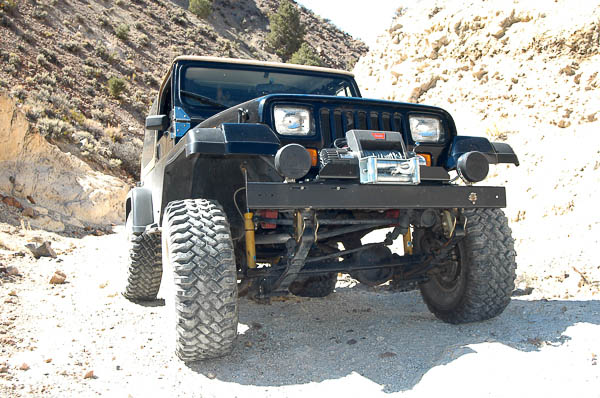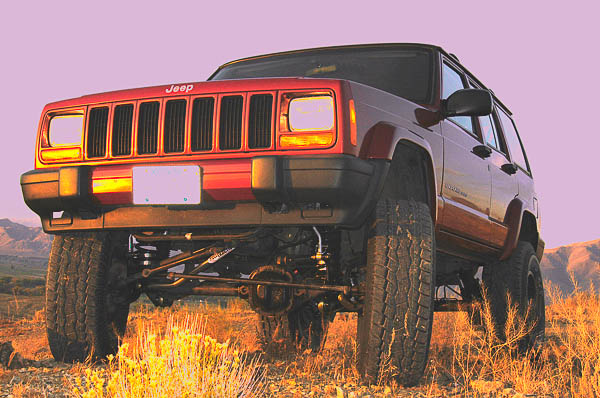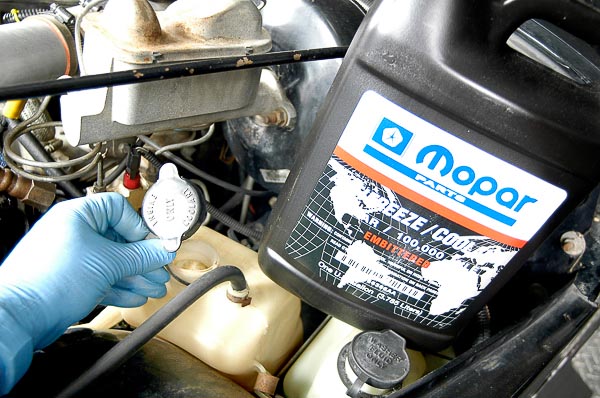
The TJ Wrangler brought a traditional Jeep 4WD utility model into the modern era. A 15% stiffer frame and Quadra-Coil® suspension distinguish this rugged model. The subsequent JK Wrangler frame is even beefier and more rigid! Chassis tuning is at the suspension level with these Jeep models. They feature many zero-maintenance components, which make periodic inspection and chassis care that much more important!
See tech articles and video ‘how-to’ throughout the magazine!
Preventive maintenance is the backbone of Jeep 4WD reliability. A hundred miles from a paved road, axle deep in snow or mud, scaling a steep rock pile or baking on a desert floor—each of these scenarios is possible for a Jeep trail runner. Built for these uses, engineered for rugged dependability under severe service, the Jeep 4WD has a longstanding reputation.
A modern Jeep 4WD has layers of backup systems that protect us from the woes of brake fluid leaks and other challenges. Durable and engineered for 150,000 or more miles of reasonable use without major repairs, a properly maintained Jeep has built-in durability. The simple failure of a serpentine drive belt, however, can deprive an engine of its cooling, prevent the battery from recharging, abruptly stop the air conditioner, and cause the loss of power assist on the steering. And miles from nowhere, a discharged battery with an automatic transmission means no way to restart the stalled engine!
Low or contaminated fluids cause powertrain or axle damage, and a dirty air filter will either starve an EFI engine of its vitally needed air/fuel supply or cause a carbureted 4.2L six to flood with gas and foul the spark plugs. Poor engine tune is a gamble for backcountry, hardcore four-wheeling. Urban and suburban Jeep owners rely upon the security of their 4WD system in foul weather, on icy, wet roads and in stop-and-go driving.

The YJ Wrangler (shown), TJ Wrangler and JK Wrangler models each feature a ladder frame. The YJ continues the tradition of vintage CJ, Willys and FSJ models with leaf springs front and rear. Semi-floater live beam axles on all Wrangler models provide ease of operation and reduced maintenance.
Hit-or-miss service is inconsistent with reliable Jeep 4WD performance. For the benefit of sensible four-wheelers, this section of 4WD Mechanix Magazine focuses on “preventive care.” As a budding mechanic, I was very fortunate. My earliest professional role was a light-and-medium duty truck fleet mechanic. Later, I worked as a heavy equipment operator and truck dealership line mechanic. The foundation of truck fleet work and equipment operation is preventive maintenance. The aim is to prevent vehicle or equipment failure in the field.
Since my teens, this strategy has dovetailed nicely with a passion for old and new Jeep 4x4s, backcountry four-wheeling and a rugged outdoor lifestyle. Preventive maintenance has brought four generations of the Ludel family safely home from the backcountry—for more than a half-century!

A current Jeep 4WD project is the 1999 XJ Cherokee. The Jeep serves on-highway in Eastern Sierra blizzards and regularly accesses rugged backcountry for 4WD Mechanix Magazine travel, photography and videography. The six-inch lifted XJ Cherokee now features a Warn 9000 lb. capacity winch, heavy duty bumpers, ARB Air Lockers front and rear plus a reinforced SYE driveline. As you would expect, I perform all of the Cherokee’s preventive maintenance, repairs and upgrade work!
Servicing your Jeep 4WD is both practical and insightful. This section of Moses Ludel’s 4WD Mechanix Magazine provides a visual and practical ‘how-to’ guide for better understanding your Jeep’s needs and improving your preventive maintenance skills. No task is trivial. Each contributes to the reliability, safety and durability of your 4×4. Backcountry survival depends upon preventive care!
Every Jeep 4WD deserves this kind of attention. By personally providing your Jeep with the maintenance, care and respect it deserves, you can enjoy the same rewards. As an added benefit of performing your own preventive care, you will develop a greater understanding of your Jeep 4WD.
Hands-on care and field troubleshooting are closely related skills. Becoming familiar with the components that make up your Jeep 4WD model will help you quickly identify damage and address problems in the field. Whether or not you do the heavier chores and in-depth work I describe, it is clearly in your best interest to perform basic, preventive care on your Jeep 4WD!
Later technology means that chassis bushings, joints and driveline components may not require service. However, this does not diminish the Jeep’s service and inspection requirements. Quite the contrary. On a 4WD Jeep vehicle that has the “permanently” sealed joints, the condition of these parts is uncertain until clear wear or actual failure occurs. Obviously, that’s too late. Regular inspection can help prevent complete parts failure in some remote area of the backcountry.

Tool requirements are minimal, and there are cost-saving benefits to performing routine Jeep service work. Join the many owners who keep their Jeep 4WDs trail ready with preventive maintenance and routine service procedures! For like-new Jeep 4WD performance, I use genuine Mopar™ products! See your local Jeep® dealer for a full line of specially formulated lubricants, vehicle care products and genuine Jeep®/Mopar™ accessories.—Moses Ludel
